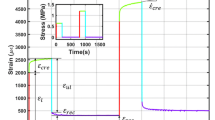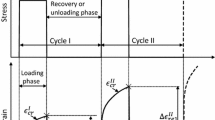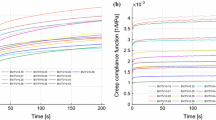Abstract
Extremely low magnitude mechanical stimuli (<10 microstrain) induced at high frequencies are anabolic to trabecular bone. Here, we used finite element (FE) modeling to investigate the mechanical implications of a one year mechanical intervention. Adult female sheep stood with their hindlimbs either on a vibrating plate (30 Hz, 0.3 g) for 20 min/d, 5 d/wk or on an inactive plate. Microcomputed tomography data of 1 cm bone cubes extracted from the medial femoral condyles were transformed into FE meshes. Simulated compressive loads applied to the trabecular meshes in the three orthogonal directions indicated that the low level mechanical intervention significantly increased the apparent trabecular tissue stiffness of the femoral condyle in the longitudinal (+17%, p < 0.02), anterior–posterior (+29%, p < 0.01), and medial-lateral (+37%, p < 0.01) direction, thus reducing apparent strain magnitudes for a given applied load. For a given apparent input strain (or stress), the resultant stresses and strains within trabeculae were more uniformly distributed in the off-axis loading directions in cubes of mechanically loaded sheep. These data suggest that trabecular bone responds to low level mechanical loads with intricate adaptations beyond a simple reduction in apparent strain magnitude, producing a structure that is stiffer and less prone to fracture for a given load. © 2003 Biomedical Engineering Society.
Similar content being viewed by others
REFERENCES
Boyd, S. K., R. Muller, and R. F. Zernicke. Mechanical and architectural bone adaptation in early stage experimental osteoarthritis. J. Bone Miner. Res.17:687694, 2002.
Callaghan, J. P., and S. M. McGill. Frozen storage increases the ultimate compressive load of porcine vertebrae. J. Orthop. Res.13:809812, 1995.
Fyhrie, D. P., and D. R. Carter. A unifying principle relating stress to trabecular bone morphology. J. Orthop. Res.4:304317, 1986.
Gross, T. S., J. L. Edwards, K. J. McLeod, and C. T. Rubin. Strain gradients correlate with sites of periosteal bone formation. J. Bone Miner. Res.12:982988, 1997.
Hahn, M., M. Vogel, M. PompesiusKempa, and G. Delling. Trabecular bone pattern factor: A new parameter for simple quantification of bone microarchitecture. Bone (N.Y.)13:327330, 1992.
Hildebrand, T., A. Laib, R. Muller, J. Dequeker, and P. Ruegsegger. Direct threedimensional morphometric analysis of human cancellous bone: Microstructural data from spine, femur, iliac crest, and calcaneus. J. Bone Miner. Res.14:11671174, 1999.
Hou, F. J., S. M. Lang, S. J. Hoshaw, D. A. Reimann, and D. P. Fyhrie. Human vertebral body apparent and hard tissue stiffness. J. Biomech.31:10091015, 1998.
Jacobs, C. R., B. R. Davis, C. J. Rieger, J. J. Francis, M. Saad, and D. P. Fyhrie. NACOB presentation to ASB Young Scientist Award: Postdoctoral. The impact of boundary conditions and mesh size on the accuracy of cancellous bone tissue modulus determination using largescale finiteelement modeling. North American Congress on Biomechanics. J. Biomech.32:11591164, 1999.
Judex, S., T. S. Gross, and R. F. Zernicke. Strain gradients correlate with sites of exerciseinduced boneforming surfaces in the adult skeleton. J. Bone Miner. Res.12:17371745, 1997.
Judex, S., and R. F. Zernicke. Highimpact exercise and growing bone: Relation between high strain rates and enhanced bone formation. J. Appl. Physiol.88:21832191, 2000.
Kabel, J., B. Van Rietbergen, M. Dalstra, A. Odgaard, and R. Huiskes. The role of an effective isotropic tissue modulus in the elastic properties of cancellous bone. J. Biomech.32:673680, 1999.
Keaveny, T. M., and W. C. Hayes. A 20year perspective on the mechanical properties of trabecular bone. J. Biomech. Eng.115:534542, 1993.
Keaveny, T. M., T. P. Pinilla, R. P. Crawford, D. L. Kopperdahl, and A. Lou. Systematic and random errors in compression testing of trabecular bone. J. Orthop. Res.15:101110, 1997.
Ladd, A. J., J. H. Kinney, D. L. Haupt, and S. A. Goldstein. Finiteelement modeling of trabecular bone: Comparison with mechanical testing and determination of tissue modulus. J. Orthop. Res.16:622628, 1998.
Mosley, J. R., and L. E. Lanyon. Strain rate as a controlling influence on adaptive modeling in response to dynamic loading of the ulna in growing male rats. Bone (N.Y.)23:313318, 1998.
Mosley, J. R., B. M. March, J. Lynch, and L. E. Lanyon. Strain magnitude related changes in whole bone architecture in growing rats. Bone (N.Y.)20:191198, 1997.
Muller, R., H. Van Campenhout, B. Van Damme, G. Van Der Perre, J. Dequeker, T. Hildebrand, and P. Ruegsegger. Morphometric analysis of human bone biopsies: A quantitative structural comparison of histological sections and microcomputed tomography. Bone (N.Y.)23:5966, 1998.
Niebur, G. L., J. C. Yuen, A. C. Hsia, and T. M. Keaveny. Convergence behavior of highresolution finite element models of trabecular bone. J. Biomech. Eng.121:629635, 1999.
O'Connor, J. A., L. E. Lanyon, and H. MacFie. The influence of strain rate on adaptive bone remodelling. J. Biomech.15:767781, 1982.
Riggs, B. L., S. F. Hodgson, W. M. O'Fallon, E. Y. Chao, H. W. Wahner, J. M. Muhs, S. L. Cedel, and L. J. Melton. Effect of fluoride treatment on the fracture rate in postmenopausal women with osteoporosis. N. Engl. J. Med.322:802809, 1990.
Rubin, C., A. S. Turner, S. Bain, C. Mallinckrodt, and K. McLeod. Anabolism: Low mechanical signals strengthen long bones. Nature (London)412:603604, 2001.
Rubin, C., A. S. Turner, C. Mallinckrodt, C. Jerome, K. McLeod, and S. Bain. Mechanical strain, induced noninvasively in the highfrequency domain, is anabolic to cancellous bone, but not cortical bone. Bone (N.Y.)30:445452, 2002.
Rubin, C., A. S. Turner, R. Muller, E. Mittra, K. McLeod, W. Lin, and Y. X. Qin. Quantity and quality of trabecular bone in the femur are enhanced by a strongly anabolic, noninvasive mechanical intervention. J. Bone Miner. Res.17:349357, 2002.
Rubin, C., G. Xu, and S. Judex. The anabolic activity of bone tissue, suppressed by disuse, is normalized by brief exposure to extremely lowmagnitude mechanical stimuli. FASEB J.15:22252229, 2001.
Rubin, C. T., and L. E. Lanyon. Regulation of bone mass by mechanical strain magnitude. Calcif. Tissue Int.37:411417, 1985.
Ruegsegger, P., B. Koller, and R. Muller. A microtomographic system for the nondestructive evaluation of bone architecture. Calcif. Tissue Int.58:2429, 1996.
Turner, C. H., V. Anne, and R. M. Pidaparti. A uniform strain criterion for trabecular bone adaptation: Do continuumlevel strain gradients drive adaptation?J. Biomech.30:555563, 1997.
Turner, C. H., I. Owan, E. J. Brizendine, W. Zhang, M. E. Wilson, and A. J. Dunipace. High fluoride intakes cause osteomalacia and diminished bone strength in rats with renal deficiency. Bone (N.Y.)19:595601, 1996.
Van Rietbergen, B., H. Weinans, R. Huiskes, and A. Odgaard. A new method to determine trabecular bone elastic properties and loading using micromechanical finiteelement models. J. Biomech.28:6981, 1995.
Van Rietbergen, B., H. Weinans, B. J. W. Polman, and R. Huiskes. Computational strategies for iterative solutions of large FEM applications employing voxel data. Int. J. Numer. Methods Eng.39:27432767, 1996.
Author information
Authors and Affiliations
Rights and permissions
About this article
Cite this article
Judex, S., Boyd, S., Qin, YX. et al. Adaptations of Trabecular Bone to Low Magnitude Vibrations Result in More Uniform Stress and Strain Under Load. Annals of Biomedical Engineering 31, 12–20 (2003). https://doi.org/10.1114/1.1535414
Issue Date:
DOI: https://doi.org/10.1114/1.1535414




